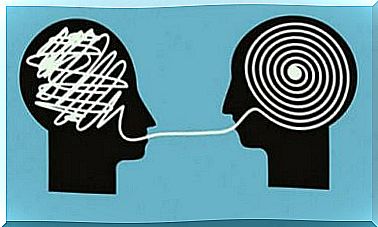Symptoms Of Premenstrual Dysphoric Disorder

Premenstrual dysphoric disorder (PMDD) is a serious, and sometimes disabling, form of PMS. Silvia Gaviria gives us one of the most appropriate definitions of premenstrual dysphoric disorder. She describes it as a set of emotional, behavioral and somatic symptoms that appear at the end of the luteal phase, and disappear again two to three days after menstruation begins.
Both PMS and PMDD can cause physical and emotional symptoms. However, in the case of premenstrual dysphoric disorder, the person may experience extreme mood swings that disrupt their work and ruin their relationship.
In both PMS and PMDD , symptoms usually begin seven to ten days before menstruation begins, and continue through the first days of menstruation. When it comes to physical symptoms, the person may experience swelling in the chest and tenderness, fatigue and changes in sleeping and eating habits.

Epidemiology
Premenstrual dysphoria is a serious form of premenstrual syndrome that affects approximately 5% of women of childbearing age. Many patients report that they experience symptoms of PMDD from the first menstrual period. It tends to become more common when women reach thirty and forty, and usually continues into menopause. In a small number of cases, the symptoms may also disappear spontaneously.
Symptoms often appear or worsen after birth, with age, after starting or stopping birth control pills, and after undergoing sterilization.
Among the many clinical variables associated with premenstrual dysphoric disorder is a history of major depressive disorder and postpartum depression, both of which also tend to occur more frequently in those who have been diagnosed with premenstrual dysphoric disorder.
Causes of premenstrual dysphoric disorder
Premenstrual dysphoric disorder is caused by a number of closely related genetic, neurobiological and endocrine factors. Most researchers believe that there may be an abnormal reaction to hormonal changes associated with the menstrual cycle.
Studies have shown an association between premenstrual dysphoric disorder and low serotonin levels. Hormonal changes can lead to a reduction in serotonin production, leading to symptoms of premenstrual dysphoric disorder.
Symptoms of premenstrual dysphoric disorder, according to DSM and ICD
Following the publication of the DSM-III-R , this disorder began to gain more attention in the world of psychiatry, under the name of late luteal dysphoric disorder. Only later, with the publication of the DSM-IV, did it become known as premenstrual dysphoric disorder.
In manuals such as ICD-10, PMDD is not considered a disorder at all, differing in both interpretation and definition of the condition. However, in the new DSM-5, premenstrual dysphoric disorder is classified as a type of depressive disorder.
To ensure an accurate diagnosis, the doctor must take a medical history and perform a physical examination. The patient should keep a calendar or diary of their symptoms to help their doctor diagnose PMDD.
You must have five or more symptoms of PMDD, including a mood-related symptom, to be diagnosed.
Diagnostic criteria for PMDD according to DSM-5
A. In most menstrual cycles, at least five symptoms must be present in the last week before menstruation begins, begins to improve within a few days after the onset of menstruation, and becomes minimal or absent in the week after menstruation.
B. One (or more) of the following symptoms must be present:
- Marked affective lability.
- Marked irritability or anger or increased interpersonal conflicts.
- Marked depressed mood, feelings of hopelessness or self-deprecating thoughts.
- Marked anxiety, tension and / or feeling of being upset or feeling irritable.
C. One (or more) of the following symptoms must be present to achieve a total of five symptoms when combined with symptoms from criterion B above.
- Reduced interest in regular activities.
- Subjective difficulty concentrating.
- Dullness, slight fatigue or marked lack of energy.
- Marked change in appetite; overeating or specific food needs.
- Hypersomnia or insomnia.
- A feeling of being overwhelmed or out of control.
- Physical symptoms such as tenderness or swelling in the chest, joint pain or muscle aches, a feeling of “bloating” or weight gain.
Note: the symptoms listed in the AC criteria must have been met in most menstrual cycles that occurred in previous years.
D. The symptoms are associated with clinically significant distress or disruption of work, school, regular social activities or relationships with others.
E. The disorder is not just an exacerbation of the symptoms of another disorder, such as major depressive disorder, panic disorder, persistent depressive disorder (dysthymia) or a personality disorder (although it may occur with some of these disorders).
F. Criterion A should be confirmed by potential daily assessments for at least two symptomatic cycles. (Note: The diagnosis can be made provisionally before this confirmation.)
G. The symptoms cannot be attributed to the physiological effects of a drug (eg substance abuse, medication, other treatment) or other medical condition (eg hyperthyroidism).

Diagnosis of premenstrual dysphoric disorder: criticism and controversy
The DSM-5 diagnostic criteria have elicited much criticism due to concerns about overpathologization. Premenstrual dysphoric disorder is at the heart of this debate. DSM-5 classifies PMDD and the symptoms experienced in the days before menstruation as a depressive disorder.
However, many experts have questioned whether it is appropriate to label half of the population with a mental illness once a month. This is the question that is at the heart of the debate. Is it really possible to pathologize a natural process based on the symptoms it causes in a small percentage of women for a few days each month?









